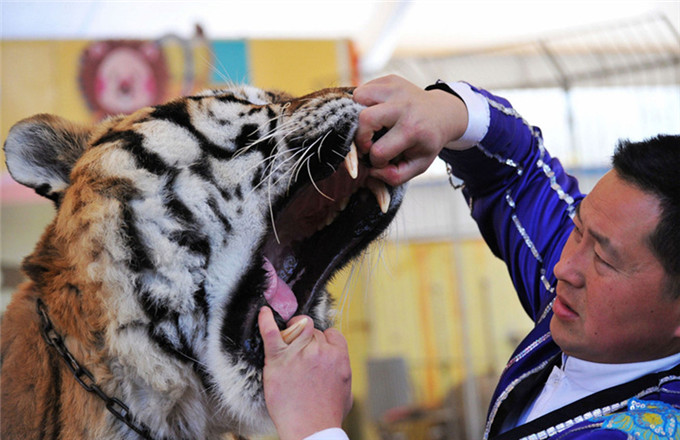Long fight to end agony and ivory
|
Michael Gachanja, executive director of the East African Wild Life Society, says the wildlife situation in Kenya has been getting worse. Li Lianxing / China Daily |
More cooperation and greater effort needed to stop trade in wildlife products
Considerable market demand for animal products is still the major threat to African wildlife and a greater effort is needed by all countries and organizations to stop it, says leading Kenyan conservationist Michael Gachanja.
Gachanja, executive director of the East African Wild Life Society, says collaboration between China and Africa to combat poaching and the illicit trade in wildlife products is still at an early stage.
Buying is mainly from Asian markets, but it was difficult to determine particular sources and outlets.
"We have been campaigning from the African end for quite a long time, enough for our people to realize how serious the problem is," he says. "But it seems to us the efforts are still far from enough to command attention on the consumption side, so we need to focus more on that.
"We need the help from those markets to identify the buyers and categorize the stakeholders and then come up with strategies to combat the illegal trade.
"Chinese tourists are not the main buyers of ivory and rhino horns now, but they are capable of influencing people around them when they return home knowing about wildlife protection."
To improve understanding in China about the African wildlife situation, the society is striving for more cooperation with Chinese partners.
Earlier this month, the society signed a Memorandum of Understanding with the Mara Conservation Fund - the first wildlife protection organization founded by a Chinese citizen in Africa and operated on site - to raise public awareness in China.
"Simba (Zhuo Qiang), the founder of MCF, is a pioneer from China in protecting African animals and he has a strong network and influence in social media like micro blogs back in China," says Gachanja. "We would like to let more Chinese people, especially those who are buying wildlife products, know about the deteriorating situation here in Kenya.
"At the end of the day, we want to create an exchange forum or platform to raise awareness and share experiences"
There is also a lot of work to be done on problems on the Kenyan side, Gachanja admits.
"People should think about why all the containers full of ivory can pass all the various inspection procedures to reach the destination market," he says. "There is evidence that officials and staff of the Kenyan Wildlife Service are involved in some poaching cases. Without permission from customs at the airport or harbor, these products would not be transferred."
Enforcement of laws and regulations, and the resulting penalties, are not strict enough to daunt further crimes, Gachanja says.
"People must ask and clarify who is facilitating the killings."
Kenya has to commit more resources to addressing the worsening situation in wildlife conservation, he adds, as safari tourism was a major economic pillar of this country.
"Look at how tourism based on natural resources, including wild animals, has contributed to the success of Kenya. People should realize the campaign needs further commitment and efforts," he says, pointing that Vision 2030, a guideline for Kenya's future development strategy, has prioritized conservation campaigns and environmental protection.
There was also the integral importance of nature and wildlife to local communities such as the Masai and Samburu to consider, Gachanja says.
"But the wildlife situation in Kenya during the past 20 years has been getting worse. The number of elephants, for example, has decreased enormously due to poaching and other factors."
Climate change and conflicts over sharing land with humans have also greatly contributed to the tragedy, he says.
"Due to the sharp increase in human population, some local tribes have had to expand their community to places that had been the territory of wild animals. So inevitably there are killings of humans and animals. More importantly, permanent settlements by people have cut off the migration routes of animals and have made propagation more difficult."
But these are not major factors when compared with poaching, which has been encouraged by the soaring international price of wildlife products, especially ivory and rhino horns, Gachanja says.
"Now poachers are all armed and the poor security situation in neighboring countries gives them easier access to arms," he says. "Conflicts in the South Sudan, Somalia and Uganda provide invisible and easier channels for poachers to acquire arms."
As well as being equipped to kill animals, poachers are also well equipped to fight rangers, making conservation efforts increasingly dangerous.
Apart from further strengthening rangers' equipment there is little that can be done to stem the illegal trade in arms unless conflict dies down and the surrounding region becomes more secure.
Gachanja believes the relationship between government and non-government organizations in China and Africa should be more effectively coordinated to ensure the efficiency of conservation activities. The countries of origin for wildlife products and those that provide the markets for them should make joint efforts to stop the slaughter.
The East African Wild Life Society was founded in 1961 when the wildlife societies of Tanzania and Kenya joined together with Uganda wildlife enthusiasts.
Gachanja started his conservation career with the forestry working group of EAWLS 18 years ago, before moving to the wildlife section in 2009.



















